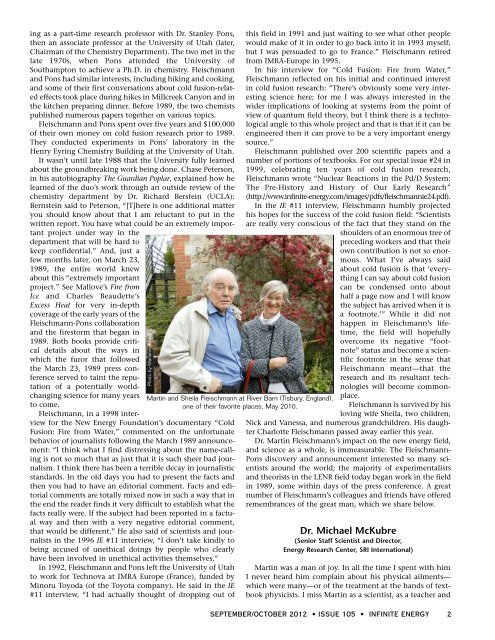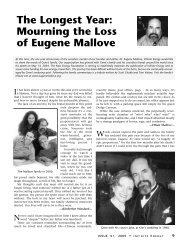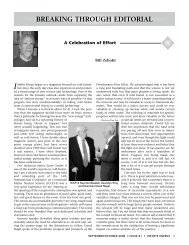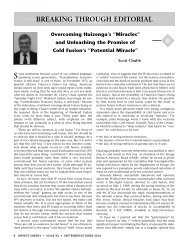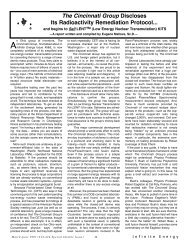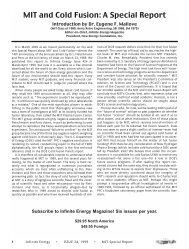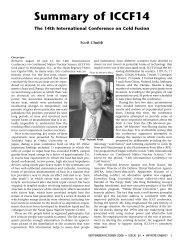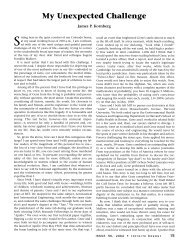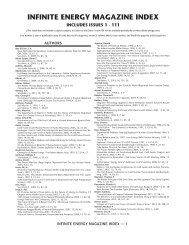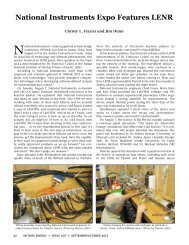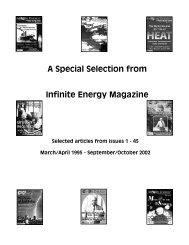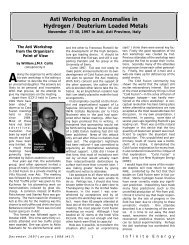Martin Fleischmann's Historic Impact - Infinite Energy Magazine
Martin Fleischmann's Historic Impact - Infinite Energy Magazine
Martin Fleischmann's Historic Impact - Infinite Energy Magazine
You also want an ePaper? Increase the reach of your titles
YUMPU automatically turns print PDFs into web optimized ePapers that Google loves.
ing as a part-time research professor with Dr. Stanley Pons,<br />
then an associate professor at the University of Utah (later,<br />
Chairman of the Chemistry Department). The two met in the<br />
late 1970s, when Pons attended the University of<br />
Southampton to achieve a Ph.D. in chemistry. Fleischmann<br />
and Pons had similar interests, including hiking and cooking,<br />
and some of their first conversations about cold fusion-related<br />
effects took place during hikes in Millcreek Canyon and in<br />
the kitchen preparing dinner. Before 1989, the two chemists<br />
published numerous papers together on various topics.<br />
Fleischmann and Pons spent over five years and $100,000<br />
of their own money on cold fusion research prior to 1989.<br />
They conducted experiments in Pons’ laboratory in the<br />
Henry Eyring Chemistry Building at the University of Utah.<br />
It wasn’t until late 1988 that the University fully learned<br />
about the groundbreaking work being done. Chase Peterson,<br />
in his autobiography The Guardian Poplar, explained how he<br />
learned of the duo’s work through an outside review of the<br />
chemistry department by Dr. Richard Berstein (UCLA):<br />
Bernstein said to Peterson, “[T]here is one additional matter<br />
you should know about that I am reluctant to put in the<br />
written report. You have what could be an extremely important<br />
project under way in the<br />
department that will be hard to<br />
keep confidential.” And, just a<br />
few months later, on March 23,<br />
1989, the entire world knew<br />
about this “extremely important<br />
project.” See Mallove’s Fire from<br />
Ice and Charles Beaudette’s<br />
Excess Heat for very in-depth<br />
coverage of the early years of the<br />
Fleischmann-Pons collaboration<br />
and the firestorm that began in<br />
1989. Both books provide critical<br />
details about the ways in<br />
which the furor that followed<br />
the March 23, 1989 press con-<br />
ference served to taint the reputation<br />
of a potentially worldchanging<br />
science for many years<br />
to come.<br />
Fleischmann, in a 1998 interview<br />
for the New <strong>Energy</strong> Foundation’s documentary “Cold<br />
Fusion: Fire from Water,” commented on the unfortunate<br />
behavior of journalists following the March 1989 announcement:<br />
“I think what I find distressing about the name-calling<br />
is not so much that as just that it is such sheer bad journalism.<br />
I think there has been a terrible decay in journalistic<br />
standards. In the old days you had to present the facts and<br />
then you had to have an editorial comment. Facts and editorial<br />
comments are totally mixed now in such a way that in<br />
the end the reader finds it very difficult to establish what the<br />
facts really were. If the subject had been reported in a factual<br />
way and then with a very negative editorial comment,<br />
that would be different.” He also said of scientists and journalists<br />
in the 1996 IE #11 interview, “I don’t take kindly to<br />
being accused of unethical doings by people who clearly<br />
have been involved in unethical activities themselves.”<br />
In 1992, Fleischmann and Pons left the University of Utah<br />
to work for Technova at IMRA Europe (France), funded by<br />
Minoru Toyoda (of the Toyota company). He said in the IE<br />
#11 interview, “I had actually thought of dropping out of<br />
Photo by Marianne Macy<br />
<strong>Martin</strong> and Sheila Fleischmann at River Barn (Tisbury, England),<br />
one of their favorite places, May 2010.<br />
this field in 1991 and just waiting to see what other people<br />
would make of it in order to go back into it in 1993 myself,<br />
but I was persuaded to go to France.” Fleischmann retired<br />
from IMRA-Europe in 1995.<br />
In his interview for “Cold Fusion: Fire from Water,”<br />
Fleischmann reflected on his initial and continued interest<br />
in cold fusion research: “There’s obviously some very interesting<br />
science here; for me I was always interested in the<br />
wider implications of looking at systems from the point of<br />
view of quantum field theory, but I think there is a technological<br />
angle to this whole project and that is that if it can be<br />
engineered then it can prove to be a very important energy<br />
source.”<br />
Fleischmann published over 200 scientific papers and a<br />
number of portions of textbooks. For our special issue #24 in<br />
1999, celebrating ten years of cold fusion research,<br />
Fleischmann wrote “Nuclear Reactions in the Pd/D System:<br />
The Pre-History and History of Our Early Research”<br />
(http://www.infinite-energy.com/images/pdfs/fleischmannie24.pdf).<br />
In the IE #11 interview, Fleischmann humbly projected<br />
his hopes for the success of the cold fusion field: “Scientists<br />
are really very conscious of the fact that they stand on the<br />
shoulders of an enormous tree of<br />
preceding workers and that their<br />
own contribution is not so enormous.<br />
What I’ve always said<br />
about cold fusion is that ‘everything<br />
I can say about cold fusion<br />
can be condensed onto about<br />
half a page now and I will know<br />
the subject has arrived when it is<br />
a footnote.’” While it did not<br />
happen in Fleischmann’s lifetime,<br />
the field will hopefully<br />
overcome its negative “footnote”<br />
status and become a scientific<br />
footnote in the sense that<br />
Fleischmann meant—that the<br />
research and its resultant technologies<br />
will become common-<br />
place.<br />
Fleischmann is survived by his<br />
loving wife Sheila, two children,<br />
Nick and Vanessa, and numerous grandchildren. His daughter<br />
Charlotte Fleischmann passed away earlier this year.<br />
Dr. <strong>Martin</strong> Fleischmann’s impact on the new energy field,<br />
and science as a whole, is immeasurable. The Fleischmann-<br />
Pons discovery and announcement interested so many scientists<br />
around the world; the majority of experimentalists<br />
and theorists in the LENR field today began work in the field<br />
in 1989, some within days of the press conference. A great<br />
number of Fleischmann’s colleagues and friends have offered<br />
remembrances of the great man, which we share below.<br />
Dr. Michael McKubre<br />
(Senior Staff Scientist and Director,<br />
<strong>Energy</strong> Research Center, SRI International)<br />
<strong>Martin</strong> was a man of joy. In all the time I spent with him<br />
I never heard him complain about his physical ailments—<br />
which were many—or of the treatment at the hands of textbook<br />
physicists. I miss <strong>Martin</strong> as a scientist, as a teacher and<br />
SEPTEMBER/OCTOBER 2012 • ISSUE 105 • INFINITE ENERGY 2


